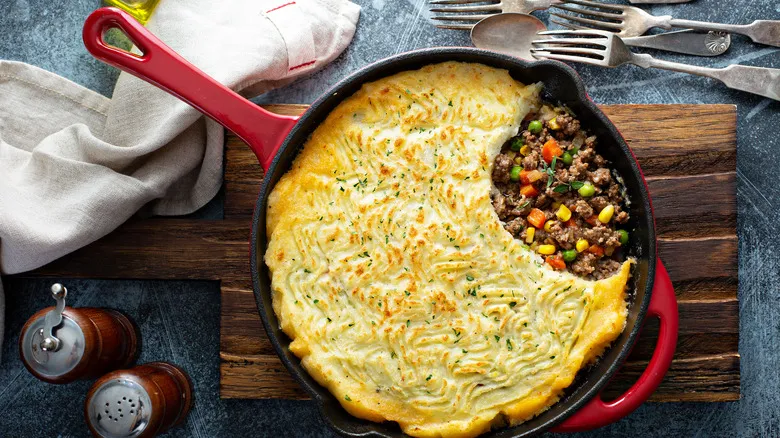The shepherd's pie grew from Ireland's occupation
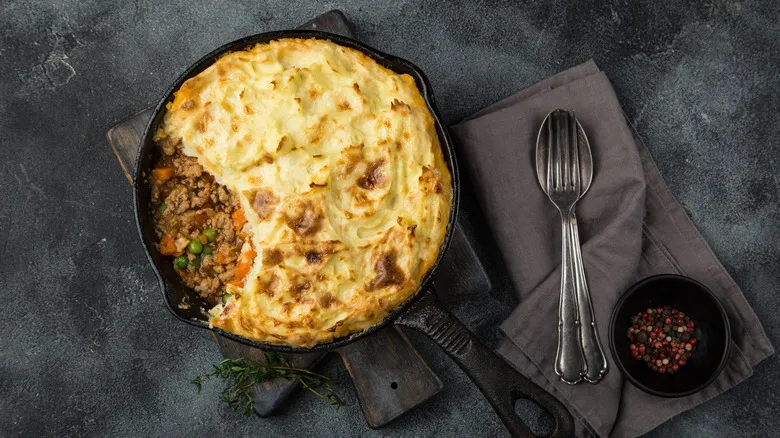
Although it's challenging to determine the exact time and person responsible for the creation of shepherd's pie, it likely emerged in the 1700s. However, the true origins of this dish extend far beyond that period. When we explore the roots of our beloved foods, we cannot detach them from the cultural and historical contexts that shaped them. Shepherd's pie, a staple of family dinners, has its origins in Britain and Ireland, but it is predominantly regarded as an Irish dish, deeply intertwined with Ireland's history.
The foundation for the development and popularity of this recipe was established centuries earlier. Relations between England and Ireland began to form in the 12th century, with England gradually exerting more control over Ireland's governance, culminating in a formal takeover in 1541. It's crucial to recognize that while Ireland had traditionally been a Catholic nation, the British were predominantly Protestant. This dynamic resulted in Irish Catholics being marginalized in society, positioned below both British and Irish Protestants. Consequently, this led to widespread poverty and food scarcity among Irish Catholic peasants. In response to these challenges, the working class in Ireland created shepherd's pie as a practical solution to fulfill their need for affordable and hearty meals (via Greatist).
The potato came to Ireland in the late 1500s

In addition to the political context, access to ingredients is a crucial element in the creation of any recipe. Shepherd's pie would not exist without one of its primary components: the potato. The combination of meat, gravy, and vegetables would be far less satisfying without the creamy mashed potato topping that completes this delicious dish.
When we consider Irish and British cuisine, the potato features prominently in many beloved recipes, but this was not always the case. It's difficult to envision a hearty Sunday roast or a St. Patrick's Day celebration without some form of prepared potato on the side. Interestingly, the potato was not introduced to Europe until the 1500s.
The common narrative suggests that Sir Walter Raleigh began cultivating potatoes on his estate after bringing them to Ireland from Virginia. However, History Ireland has highlighted some inconsistencies in this account, notably that Raleigh never actually visited Virginia. It is much more plausible that the potato gradually gained popularity after being brought to Europe from South America, eventually making its way from England to Ireland. Potatoes then became a vital crop for the Irish due to their ease of cultivation, nutritional value, and affordability.
The creation of the cottage pie
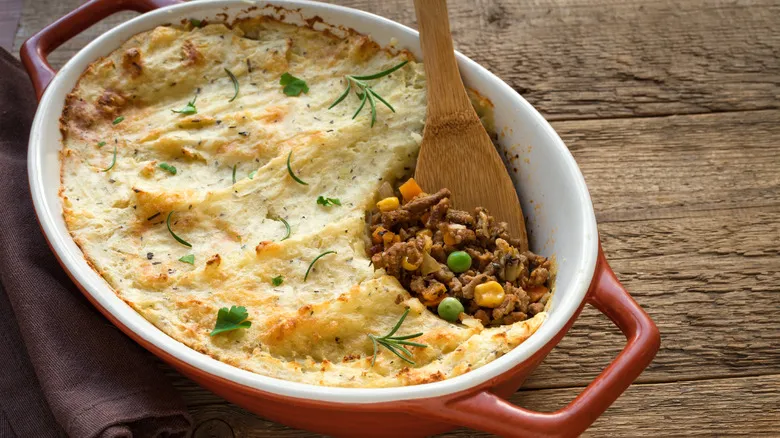
Shepherd's pie and cottage pie share more similarities than differences. In fact, these terms are often used interchangeably to describe any dish featuring ground meat and vegetables in gravy topped with mashed potatoes. However, if we want to be precise, the distinction lies in the type of meat used. Cottage pie is traditionally made with ground beef (and sometimes other meats), while shepherd's pie is prepared with lamb.
Despite this difference, the two dishes are so alike that many families today prepare their versions with ground beef and still refer to it as shepherd's pie. The connection between the two is so strong that shepherd's pie may not have even existed without cottage pie. According to Greatist, cottage pie, which predates shepherd's pie, began appearing in British and Irish homes in the 1700s. It was named "cottage pie" likely because it was a dish primarily prepared by the poorer, working-class individuals living in cottages.
The working class couldn't afford beef

Shepherd's pie is more commonly linked to Ireland than cottage pie, which came first. The primary distinction between these two dishes is that cottage pie is made with ground beef, while shepherd's pie features lamb. This difference likely stems from the fact that, during the time the dish was developed, many working-class Irish families could not afford beef. In the 17th century, Ireland had an abundance of cattle due to British landowners introducing them, which made the Irish famous for exporting corned beef—a dish now closely tied to the St. Patrick's Day celebration.
However, while Irish laborers farmed and exported beef, they generally could not afford to consume it themselves, as beef was regarded as a luxury. In contrast, lamb was more affordable, making it a practical choice for many Irish households (according to History Cooperative). This is likely why lamb or mutton was also used in Irish stew. The use of mutton or lamb instead of beef ultimately led to the naming of the Irish meat pie as "shepherd's pie," in honor of the shepherds who cared for the sheep.
Shepherd's pie was used to avoid waste

The concept behind cottage and shepherd's pie originated from the need to utilize leftover meat and vegetables from earlier meals. Wasting food is never ideal, and during times of poverty and food scarcity, many working-class families recognized the importance of maximizing every bit of food available. For many workers, the uncertainty of when their next meal would arrive made it crucial to repurpose kitchen scraps and leftovers, turning frugality into a necessity.
As noted by Greatist, cottage and shepherd's pie was often crafted from leftover meat from the previous evening's meal. Instead of discarding scraps of lamb or mutton, home cooks combined these remnants with whatever vegetables were on hand. The clever addition of mashed potatoes followed, as potatoes were both inexpensive and hearty. This mashed potato topping provided a perfect way to elevate the leftovers into a completely new and satisfying dish, helping to ensure that no one went hungry.
The recipe was first referenced in writing in 1791

Determining the precise origin of recipes can be quite challenging. With traditional family meals like shepherd's pie, there isn't a specific chef or restaurant we can identify as the originator of the dish. It's likely that the recipe was passed down orally from one family to another, resulting in numerous variations over the years.
As noted by History Cooperative, the earliest written mention of cottage pie dates back to a diary entry from 1791. However, versions of both cottage and shepherd's pie were certainly prepared and enjoyed by Irish and British families well before that time. Reverend James Woodforde meticulously documented his daily life in his extensive diaries, and in 1791, he recorded an entry about having "Cottage-Pye and rost Beef."
It wasn't until several decades later that the lamb variant of the dish was documented. In her 1806 book, "New System of Domestic Cookery: Formed Upon Principles of Economy; and Adapted to the Use of Private Families," Maria Rundell included a recipe featuring minced mutton (or beef) topped with mashed potatoes. Although this recipe clearly resembles shepherd's pie, she referred to it as "sanders."
The Scottish version of Shepherd's pie appeared in the 19th century
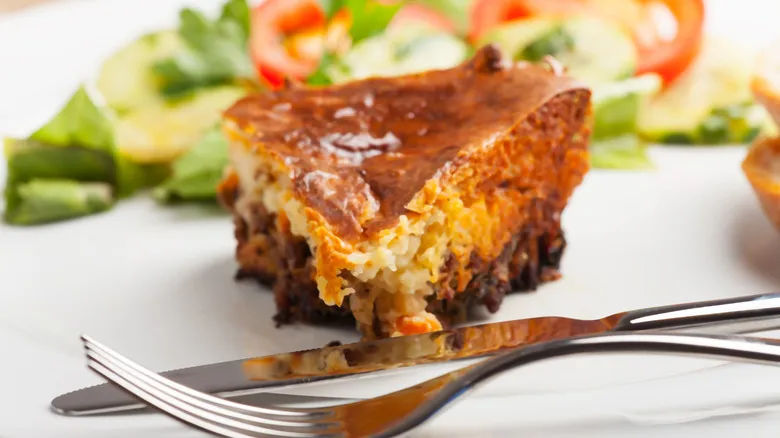
Shepherd's pie is often regarded as an Irish dish, but as previously mentioned, its origins are closely linked to England as well. Approximately a century after cottage and shepherd's pie became established in Britain and Ireland, a different variation of the dish emerged in Scotland.
This Scottish version was mentioned in an 1877 English cookbook, which referred to it as "shepherd's pie." Notably, this marks the first documented instance of the term "shepherd's pie" in relation to this hearty meat dish. However, the Scottish recipe mentioned in the book differs from the traditional Irish shepherd's pie. The main distinction lies in the Scottish version, which featured a potato crust topped with an additional layer of wheat flour or a thin pastry crust.
Earlier, in 1862, a similar dish with a flour crust was noted in a Scottish cookbook, although it was not specifically labeled as shepherd's pie (according to Britannica). The inclusion of flour is not a common element in most contemporary shepherd's or cottage pie recipes.
More international variations on shepherd's pie

Numerous regions have their unique interpretations of the beloved shepherd's pie. While the traditional Irish recipe—featuring minced meat, vegetables, and a potato topping—remains the version most people envision as the classic shepherd's pie, countless variations exist. The concept of repurposing leftovers into a meat pie resonates across cultures, and incorporating potatoes into the dish enhances its heartiness, explaining the multitude of adaptations.
For instance, the Scottish variation includes a flaky pastry crust layered over the potatoes, while other regions have made their own modifications. In Canada, there's Pâté chinois, sometimes also called shepherd's pie, which consists of a mixture of beef and sweet corn topped with mashed potatoes. Portugal offers its own take on a straightforward meat dish with mashed potatoes, typically using veal. Additionally, Pastel de papas, popular in Chile and Argentina, represents yet another regional twist on shepherd's pie.
Shepherd's Pie today
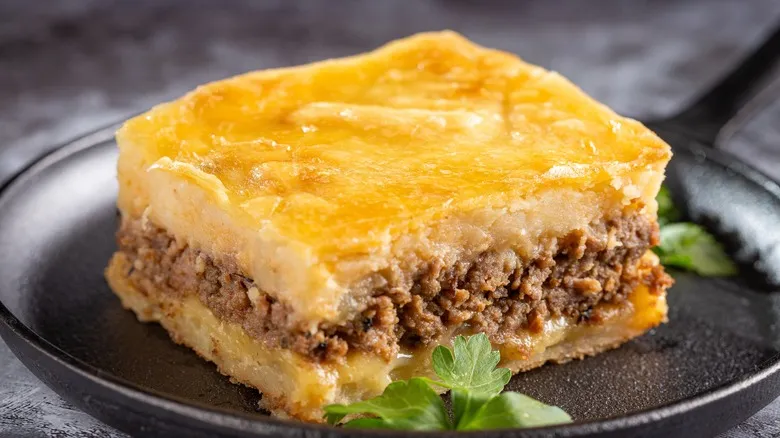
Shepherd's pie has truly endured through the ages, remaining a cherished dinner option hundreds of years after it was first created. Today, it is a beloved comfort food enjoyed across the UK, the United States, and various other regions around the world. Due to the relatively high cost of lamb in the United States, many home cooks choose to use ground beef for their Irish meat pie, often still calling it shepherd's pie. Nevertheless, it closely resembles the original Irish recipe.
This classic minced meat dish was initially crafted out of necessity from leftover ingredients. Over time, it has evolved into a family tradition, with many people purchasing ingredients specifically to prepare shepherd's pie for dinner. You can even find ready-made versions of this dish in the frozen food aisle of your local grocery store.
Regardless of how you prepare it, this meat pie remains the ideal recipe to keep you warm and content. It is especially enjoyable during the fall and winter months when hearty, warming meals are most sought after. Additionally, you can order shepherd's pie at many Irish pubs for an authentic take on this traditional dish to accompany your pint.
Recommended

A History Of Lenten Fish Frys

The History Of Sweet And Sour Sauce

Is Trader Joe's Or Costco A Better Place For Charcuterie Board Shopping?

Ina Garten's Valuable Tip On Bringing Host Gifts
Next up

